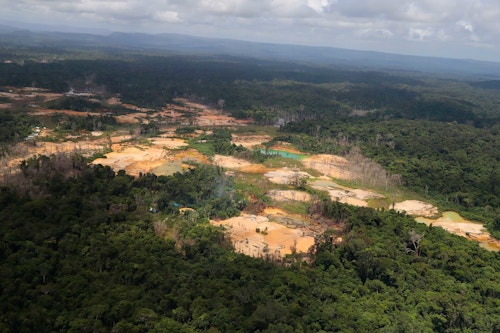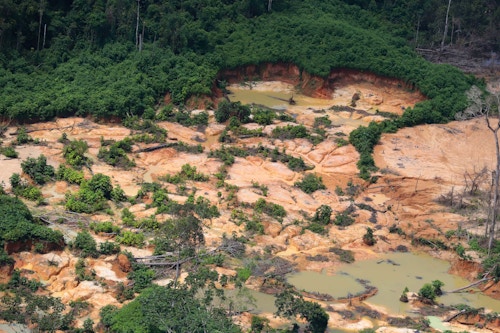Gold rush can spark Covid-19 epidemic in the Yanomami territory
Illegal miners are rushing into the Yanomami territory and 40 percent of the people living near mine sites could get infected with Covid-19.

The yanomami village of Demini. Photo: Vincent Rosenblatt
A new study by the Socio-environmental Institute (ISA) carried out in partnership with the Federal University of Minas Gerais (UFMG), and reviewed by Fiocruz (Oswaldo Cruz Foundation for Public Health), estimates that in a worst- case scenario 5,600 Yanomami could be infected by Covid-19 in the time to come.
That’s a compelling figure, considering that only 27,000 people live in the Yanomami Indigenous Territory, about the size of Portugal.
However, an ongoing and illegal gold rush has drawn 20,000 miners into the territory. Many of them regularly travel between the Yanomami territory and other parts of Brazil. Brazil is one of the worst- hit countries in the world in terms of Covid-19.
"This situation of garimpeiros [illegal miners] is very worrying. The Yanomami are suffering a lot from the threat of death, from diseases like malaria and Covid-19. The situation is very worrying. Today the Yanomami land is being destroyed", says Dario Kopenawa, vice-president of Hutukara Yanomami Association.
Hutukara is among the organizations behind the newly launched campaign Miners Out, Covid Out, which aims to pressure the government to expel the miners from the Yanomami Territory.

Dario Kopenawa. Photo: Victor Morayama/ISA
Epidemics killed thousands in the 70s and 80s
The current invasion could prove a disaster for the Yanomami people: The disease could infect as many as 40% of the Yanomami who live in mining zones (13,889), and in a worst-case scenario, almost 900 of the infected could die.
If the epidemic strikes with full force, history will be repeating itself in a cruel manner for the Yanomami. They lived in relative tranquility until the mid-1970s when pressures on their territory intensified. In 1976 the first miners arrived, and in the late-1980s, it was estimated that almost 50,000 miners were active in the forest.
As the Yanomami had no natural protection against the diseases that the miners brought, the 70s and the 80s turned out to be a dark chapter in the Yanomami history:
- 22% of the population in four villages died from infectious diseases in 1974 and 1975.
- Two years later, another 50% of the inhabitants of four other communities succumbed to a measles epidemic.
- From mid-1987 to January 1990, the height of the gold rush, it is estimated that about a thousand Yanomami, that is 14% of their population in Roraima, died mainly from diseases such as malaria.
The current mining invasion is explained by the increase in the price of gold internationally, the weakening of official policies to protect indigenous peoples' rights and the environment, and pressure from the current government in favor of the legalization of mining on indigenous lands.

Illegal mining site in the Yanomami terriory. Photo: Chico Batata/Greenpeace

Illegal mining site in the Yanomami terriory. Photo: Chico Batata/Greenpeace

Illegal mining site in the Yanomami terriory. Photo: Chico Batata/Greenpeace

Illegal mining site in the Yanomami terriory. Photo: Chico Batata/Greenpeace

ILLEGAL: Illegal mining site in the Yanomami terriory. Photo: Chico Batata/Greenpeace

Picture taken during an epidemic in a Yanomami community in 1990. Photo: Charles Vincent/ISA
The Army discontinued inspection operations in the Yanomami Indigenous Territory in 2018, and the four FUNAI Ethno-Environmental Protection Bases (BAPEs) in the territory were closed, leaving it unprotected.
Recent satellite photos reveal the destruction that illegal mining has caused inside the Yanomami Indigenous Territory over the past year.
The Yanomami are vulnerable
According to the study, the Yanomami are the people most susceptible to the pandemic in the entire Brazilian Amazon, due to a combination of different factors:
- The Yanomami, like other indigenous peoples, share their homes with several families, as well as drinking vessels and household items. If a highly contagious disease like Covid-19 enters the community, it is very difficult to prevent its transmission.
- The Yanomami have a high incidence of diseases that can worsen the coronavirus infection. The number of deaths related to acute respiratory infections has increased in recent years.
- The health posts that serve the Yanomami Indigenous Territory have the highest vulnerability among the 172 studied in Brazil. They have the lowest availability of beds and ventilators, the greatest limitations relating to transportation of the sick and the worst levels of social vulnerability.
- The high degree of social vulnerability indicates that the population served by these health posts has the worst life expectancy at birth, low levels of education as per the Human Development Index (HDI), a high percentage of the population living in extreme poverty, people in households with inadequate water and sanitation supplies, and no running water.
The study concludes that Brazilian law obligates the Brazilian State to guarantee the territorial integrity of indigenous lands against invasions and to take measures to ensure their permanent possession by indigenous peoples. It also calls on the authorities to take immediate steps to protect the Yanomami.
